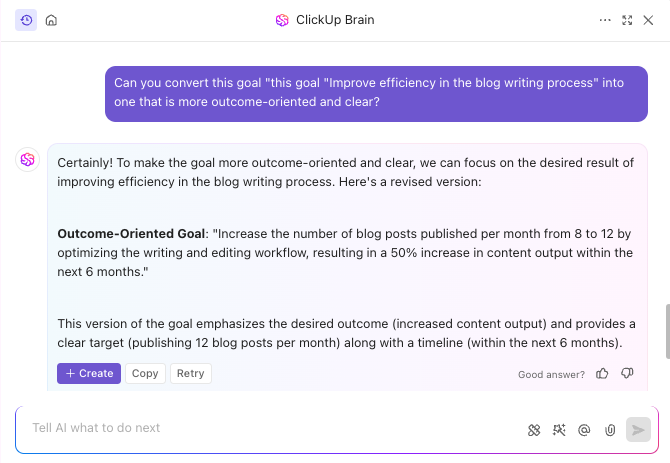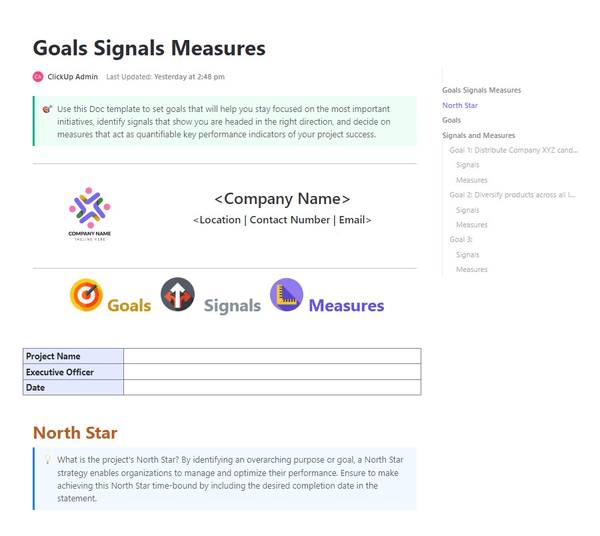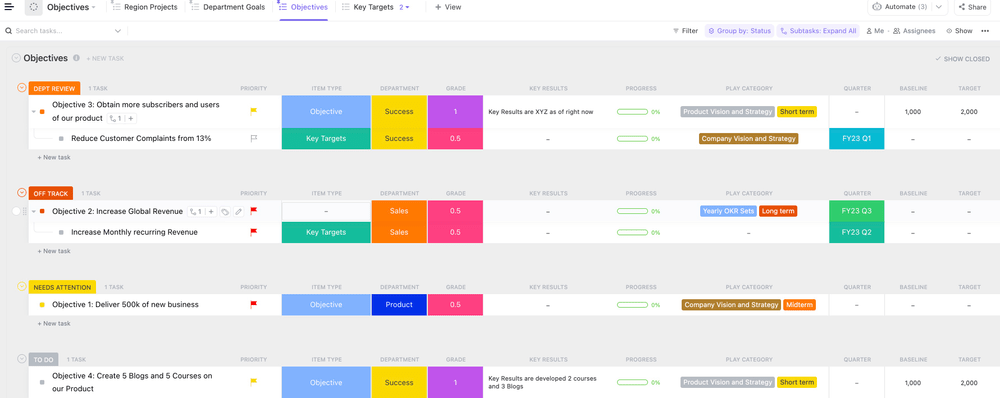Locke’s Goal-Setting Theory of Motivation

Sorry, there were no results found for “”
Sorry, there were no results found for “”
Sorry, there were no results found for “”

Goal-setting is an exercise we undertake periodically in our personal and professional lives. Often, this is underlined by the fear that we may not achieve our goals. The key is to refine the goal-setting process and set challenging but achievable goals.
Realistic, attainable goals are easier to achieve. If not, they give us a lifetime lesson on self-efficacy.
Locke’s goal-setting theory is an age-old framework that teaches us how to set specific goals—for yourself or your team members.
If you want to up your goal-setting game, this article is for you. We dive deeper into Locke’s goal-setting framework, its principles, and how to leverage goal-setting theory for your organization.
Dr. Edwin. A. Locke published the goal-setting theory of motivation in 1968 based on his goal-setting research.
The goal-setting theory, also known as the ‘goal-setting theory of motivation,’ states that specific, clear, and challenging goals motivate employees and improve their self-efficacy more than generic, vague goals. When employees are motivated, they are more likely to achieve challenging goals, which leads to better performance.
The goal-setting theory establishes a relationship between the goal-setting process and task motivation. As a manager, when you understand the essentials of Locke’s practically useful theory for goal attainment, you can set actionable team goals centered around the team’s objectives and improve your personal goal setting.
📽️ Bonus Watch: Check out this visual explainer of how to set professional goals and surge forward in your career!
The foundations of Locke’s goal-setting theory of motivation are the five principles—clarity, challenge, commitment, feedback, and complexity.
These principles guide managers to achieve the organization’s goals and improve self-efficacy and intrinsic motivation for the workforce.
According to goal-setting theory, setting clear and specific project goals for your employees would mean less room for misunderstandings and more possibilities for higher performance.
A clear goal is actionable and explains to the employee what needs to be done. They are motivated to hit those goals.
For example, ‘Create a content strategy for a website’ is not an explicit goal as it doesn’t specify any metrics, timeframes, or the purpose of the goal. A more explicit goal is to ‘Create a content strategy for the X website to reach 100K traffic within the next 90 days.’
This goal explicitly mentions the website’s name, purpose, and timeframe. A straightforward metric for the manager is to track the employee’s task performance at the end of the 90 days.
To make a goal clear, make sure to add:
Alternatively, try ClickUp Brain to vague, open-ended goals into specific, outcome-oriented ones.

The goal-setting theory states that you should set challenging goals for your team. A challenging business goal makes them feel valued and increases their task motivation level. Challenging goals also improves personal goal-setting.
When you set specific and challenging goals for complex tasks, you’re more likely to push yourself to achieve them.
For example, a challenging learning goal for an experienced product marketing manager would be ‘Creating an interactive product demo for the sales team that helps them explain the product features quickly and easily.’
To make your professional goals challenging, ask these questions:
The goal-setting theory states that an employee must be aligned with the goal you are setting for them, also known as goal commitment. If they agree with you on the goal, they will likely succeed in achieving the goals.
To ensure goal commitment:
You cannot set goals, assign them to an employee, sit back, and relax as per the goal-setting theory.
As a manager, you are responsible for regularly communicating with your team members, checking their progress, sharing detailed feedback at each step, and helping them find a distinct place in the organizational behavior.
Set goal-relevant activities and a feedback mechanism to motivate the employees, communicate the impact of achieving the goal in overall business operations, and direct them towards higher performance. Your feedback will help the employees progress and hit the goal.
To build a solid feedback-sharing process:
While employees appreciate a challenging goal, managers must balance the ‘challenge’ and ‘task complexity’ elements. In his goal-setting theory, Locke mentions that an overly complicated goal might overwhelm the employees and reduce their self-efficacy.
This will result in reduced chances of achieving the goal. Assign goals matching employees’ expertise and skills or break down a complex task into multiple small tasks so they gain confidence in their abilities and hit the goals.
Ask these questions to ensure your goal is not overtly complex:
Let’s understand the concept of goal-setting theory with a real-world scenario.
When new employees join an organization, they are excited to start a new journey and find their voice in organizational behavior. It is the responsibility of the employer or manager to set the appropriate goals that increase their self-efficacy and achieve their productivity goals successfully.
A common practice in many organizations is to provide the employees a 30 to 60-day time (or, in some cases, more) to ‘settle in’ before assigning them meaningful tasks. During this period, the managers ask employees to review existing resources and documentation to understand their future responsibilities.
While that is a good practice, sometimes it demotivates the employees and reduces job satisfaction. Experiential learning is a great learning process; however, managers should change their management perspectives and incorporate more practical ways to onboard the employee.
For example, replace vague sales goals like ‘Read the entire sales playbook’ with ‘Read the Lead Generation chapter of the sales playbook within five days and write down your actionable feedback on our current prospecting process.’
While specific and challenging goals encourage the employee to read the sales playbook, the second goal satisfies the goal-setting theory.
As per the goal-setting theory, ensure that the employee is committed to the goal and there is not too much task complexity. There should be a solid feedback system so the manager can share their feedback on the assigned task once it is complete.
The goal-setting theory clearly shows what to achieve, how to achieve it, and how to measure your task performance. A clear roadmap helps the employees plan their challenging tasks and maintain organizational behavior and managers to track their team’s progress.
The goal-setting theory encourages motivation building. This theory aims to make the employees feel valued by assigning them meaningful goals.
The American psychologist Locke’s theory of motivation focuses on setting measurable goals to improve human performance and ensure goal orientation. By specifying the key metrics like time duration while setting SMART goals, managers ensure that tasks are completed within pre-defined timelines.
While the goal-setting theory believes that challenging goals motivate the team, it is not always the case. Sometimes, a complicated goal, goal conflict, or a broadly defined challenging goal creates mental pressure on the employees, leaving them overwhelmed and not hitting the goal.
There is a fine line between challenge and task complexity. While the goal-setting theory asks to strike a balance, employers often cross this line and set unrealistic goals that are not attainable. The result is miscommunication with employees, dissatisfaction, affected human performance, and an impact on the person’s well-being.
When employees are forced to achieve unrealistic, vague goals, it triggers them to take unethical approaches and deviates them from goal orientation. They may try shady activities and get into unhealthy arguments with their colleagues to achieve those ‘challenging goals.’ All these are likely to affect their mental health and organizational behavior.
When setting team goals, clearly communicate what you are trying to achieve.
For instance, you want your employees to learn how to use goal-setting software. Define why you want them to learn the software. If your organizational commitment is to improve efficiency and streamline project management, let them know this software will help them improve their project management skills.
When your employees are convinced that their goals are in sync with your organizational settings, it becomes easier to get their buy-in. Employee buy-in is critical to the success of the goal-setting theory.
Once you’ve defined your goals, share your vision for the goal with your team or employees. Ask them what they need to achieve and equip them to achieve those goals.
Make goal-setting a two-way process and ask for their input. Ensure everyone knows the organizational performance and what’s expected of them.
As a manager, ensure these goals align with their personal goals so they would be committed to hitting them.
For example, sales reps who want to become sales managers should learn how to write better cold emails using AI. This is in sync with their own goals to become a sales manager and your goals of promoting reps to managers based on subsequent performance instead of hiring new managers.
Pro tip: Goals should be time-bound. Otherwise, they will stretch to eternity. For example, in Q1 of 2024, you want all sales reps to learn to use ChatGPT to write better cold emails.
Whether personal or professional, the SMART framework helps you create a realistic goal with a clear timeline and identify missed targets.
Your goals should be:
The truth is that goals should be flexible. If the goal is too ambitious or the timeline unrealistic, be flexible to adjust the goal as needed.
While Locke’s goal-setting theory helps teams improve their performance, you must personalize the goals according to your organizational dynamics.
ClickUp is purpose-built to help you do that.
Here’s how.
Step 1: Create trackable goals
Use ClickUp Goals to connect your targets to your work/team goals, track progress, and manage all your goals in one place.
Break down large, complex tasks into smaller goals, categorize each goal, and assign them to the team members with appropriate expertise.

Step 2: Use goal-setting templates to streamline your process
Don’t waste your time creating your goal-setting processes from scratch. Instead, use ClickUp’s goal-setting templates to get started quickly.
Some of the most widely used templates are:
ClickUp’s SMART Goals Template organizes goals into a manageable system that supports your daily, monthly, and annual goal-setting. The template visualizes the progress to keep everyone motivated. Whether launching a new product line or project, this template ensures your team stays focused and on track.

The Goals Signals Measures Template by ClickUp defines goals, signals, and measures for a clear understanding of success. With automated notifications, managers can track progress against goals and prioritize tasks based on their impact.

This template allows you to gather data for the identified signals, such as team performance, personal goals, and other information relevant to your performance relationship.
Use ClickUp’s Company OKRs and Goals Template to organize your goals at a high level, specify success criteria for each, develop a goal-setting process, and track the progress of the goals for a specific period.

Bonus: Manage all your goal-setting documents in one place, in a shared, secured folder to track your OKRs over a sprint, and manage individual employee scorecards to ease the human decision processes.
If you are struggling with:
With ClickUp, you have a goal-setting app to streamline the entire process.
ClickUp is an efficient tool to help your employees achieve a goal-setting mindset that matches your organizational psychology.
The key features that make ClickUp the best tool to implement and track challenging goals and goal commitment are:
What’s the best way to implement Locke’s Goal-Setting Theory?
Set your team goals. Assign them to team members. Track progress. Voila!
© 2025 ClickUp